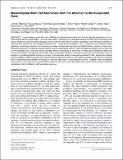Mesenchymal Stem Cell Mechanics from the Attached to the Suspended State
Author(s)
Maloney, John M.; Nikova, Dessy; Lautenschläger, Franziska; Clarke, Emer; Langer, Robert; Guck, Jochen; Van Vliet, Krystyn J.; ... Show more Show less
DownloadMaloney-2010-Mesenchymal Stem Cel.pdf (808.5Kb)
PUBLISHER_POLICY
Publisher Policy
Article is made available in accordance with the publisher's policy and may be subject to US copyright law. Please refer to the publisher's site for terms of use.
Terms of use
Metadata
Show full item recordAbstract
Human mesenchymal stem cells (hMSCs) are therapeutically useful cells that are typically expanded in vitro on stiff substrata before reimplantation. Here we explore MSC mechanical and structural changes via atomic force microscopy and optical stretching during extended passaging, and we demonstrate that cytoskeletal organization and mechanical stiffness of attached MSC populations are strongly modulated over >15 population doublings in vitro. Cytoskeletal actin networks exhibit significant coarsening, attendant with decreasing average mechanical compliance and differentiation potential of these cells, although expression of molecular surface markers does not significantly decline. These mechanical changes are not observed in the suspended state, indicating that the changes manifest themselves as alterations in stress fiber arrangement rather than cortical cytoskeleton arrangement. Additionally, optical stretching is capable of investigating a previously unquantified structural transition: remodeling-induced stiffening over tens of minutes after adherent cells are suspended. Finally, we find that optically stretched hMSCs exhibit power-law rheology during both loading and recovery; this evidence appears to be the first to originate from a biophysical measurement technique not involving cell-probe or cell-substratum contact. Together, these quantitative assessments of attached and suspended MSCs define the extremes of the extracellular environment while probing intracellular mechanisms that contribute to cell mechanical response.
Date issued
2010-10Department
Massachusetts Institute of Technology. Department of Biological Engineering; Massachusetts Institute of Technology. Department of Chemical Engineering; Massachusetts Institute of Technology. Department of Materials Science and EngineeringJournal
Biophysical Journal
Publisher
Elsevier
Citation
Maloney, John M., Dessy Nikova, Franziska Lautenschläger, Emer Clarke, Robert Langer, Jochen Guck, and Krystyn J. Van Vliet. “Mesenchymal Stem Cell Mechanics from the Attached to the Suspended State.” Biophysical Journal 99, no. 8 (October 2010): 2479–2487. © 2010 Biophysical Society
Version: Final published version
ISSN
00063495
1542-0086